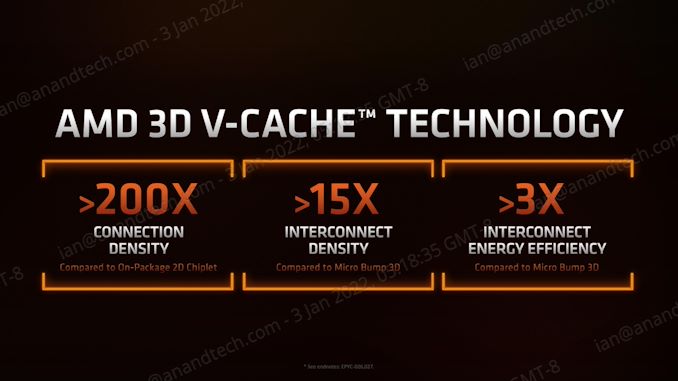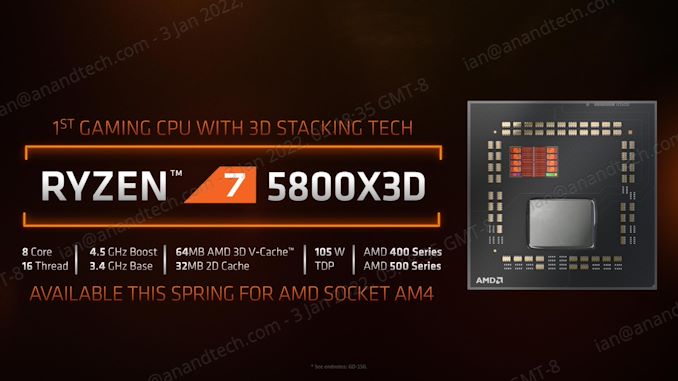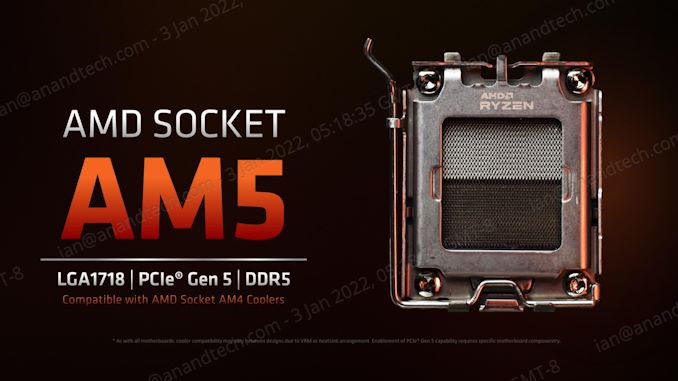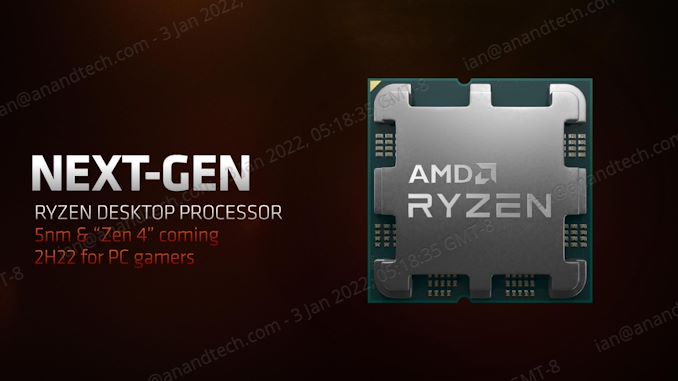One of many issues I look ahead to yearly is whether or not the foremost corporations I write about are ready to showcase their upcoming merchandise upfront – as a result of the 12 months begins with the annual CES commerce present, that is the right place. An organization that’s in a position to current its 12-month portfolio comes throughout as assured in its capability to ship, and it additionally will get the remainder of us salivating on the prospect of next-generation {hardware}. This time round AMD steps as much as the plate to speak about its new V-Cache CPU coming quickly, and its new Zen 4 platform coming within the second half of the 12 months.
Now with V-Cache! One Sole CPU: Ryzen 7 5800X3D
Each CPU has ranges of inside reminiscence, referred to as cache, which begins as a financial institution of ‘Degree 1’ quick however small reminiscence, rising as much as a ‘Degree 2’ medium-sized medium velocity reminiscence, after which a ‘Degree 3’ bigger sized slower reminiscence. Past this there’s the primary DDR reminiscence, which is tremendous massive, however tremendous gradual compared – primary reminiscence is 100x slower to entry, however can maintain much more information.
Final 12 months AMD introduced that it had been engaged on stacked onboard reminiscence within the type of cache. This V-Cache idea took one of many commonplace 8 core chiplets from the Ryzen 5000 sequence, which already had 32 MB of L3 cache, and stacked on prime of it one other 64 MB of L3 cache, giving a complete of 96 MB. Stacking chips is tough, and AMD has been working with TSMC to productize this superior packaging approach.
The primary 8-core chiplet, constructed on TSMC 7nm, measures 82 mm2. This additional stacked chiplet is barely 36 mm2, and sits straight above the cache already on the chip, so it doesn’t cowl the cores. The additional 64 MB of L3 cache chiplet is manufactured on a model of TSMC 7nm that’s optimized for cache density, and so AMD has positioned 64 MB on prime of 32 MB straight. The cores should not coated for thermal causes – the cores are the place the facility is used, and so thermal areas are positioned on prime to make the highest of the mixed chip absolutely flat.
AMD acknowledged final 12 months that it will be manufacturing shopper and enterprise variations of this elevated cache in 2021 for launch in 2022. On the Information Middle occasion final 12 months in November, AMD introduced the model that will go into servers, and known as it Milan X. For shoppers, AMD is saying immediately what this elevated cache model of Ryzen seems to be like. Introducing, the Ryzen 7 5800X3D.
AMD is barely going to launch a single Ryzen model of its V-Cache expertise, utilizing the Ryzen 7 5800X as a base. This implies the chip is 8 cores, 16 threads, and 105 W TDP identical to the common R7 5800X, however with 96 MB of L3 cache now somewhat than 32 MB. It is going to run at 3.4 GHz Base, 4.5 GHz enhance, be overclockable, and work in AMD 400-series and 500-series motherboards.
| AMD Ryzen 5000 Collection Processors for Desktop Zen 3 Microarchitecture (Non-Professional, 65W+) |
|||||||||
| AnandTech | Core/ Thread |
Base Freq |
1T Freq |
L3 C$ |
IGP | PCIe | TDP | SEP | |
| Ryzen 9 5950X | 16 | 32 | 3400 | 4900 | 64 MB | – | 4.0 | 105 W | $799 |
| Ryzen 9 5900X | 12 | 24 | 3700 | 4800 | 64 MB | – | 4.0 | 105 W | $549 |
| Ryzen 9 5900 | 12 | 24 | 3000 | 4700 | 64 MB | – | 4.0 | 65 W | OEM |
| Ryzen 7 5800X3D | 8 | 16 | 3400 | 4500 | 96 MB | – | 4.0 | 105 W | ? |
| Ryzen 7 5800X | 8 | 16 | 3800 | 4700 | 32 MB | – | 4.0 | 105 W | $449 |
| Ryzen 7 5800 | 8 | 16 | 3400 | 4600 | 32 MB | – | 4.0 | 65 W | OEM |
| Ryzen 7 5700G | 8 | 16 | 3800 | 4600 | 16 MB | Vega8 | 3.0 | 65 W | $359 |
| Ryzen 5 5600X | 6 | 12 | 3700 | 4600 | 32 MB | – | 4.0 | 65 W | $299 |
| Ryzen 5 5600G | 6 | 12 | 3900 | 4400 | 16 MB | Vega7 | 3.0 | 65 W | $259 |
| Ryzen 3 5300G | 4 | 8 | 4000 | 4200 | 8 MB | Vega6 | 3.0 | 65 W | OEM |
The processor will launch within the Spring (March/April we expect), and actual pricing is but to be introduced.
For these which have been following AMD’s V-Cache information over this previous 12 months, I wager you’ve gotten precisely the identical questions I did when AMD first briefed us on this announcement. Here’s a abstract of the questions I requested, and my interpretations of the responses.
Why solely Ryzen 7, not Ryzen 5/Ryzen 9? As a result of this can be a new undertaking for AMD, they need to learn the way a processor like this will probably be welcomed into the market. A variety of customers (myself included) anticipated AMD to go all-in with a giant 16-core model, nevertheless something Ryzen 9 requires two chiplets, and including the additional V-Cache does require an additional price in silicon and packaging. Throughout a semiconductor scarcity, I used to be informed that that is the easiest way to get it into the arms of many individuals whereas additionally not within the tremendous high-cost bracket. It additionally means one single unified 96 MB of L3 cache, with out having to cope with two chiplets value which could not be optimized instantly. Future variations of V-Cache on next-generation merchandise could also be expanded to different Ryzen family members.
The frequencies are decrease than the common 5800X? The cache does add a number of watts to the facility each by way of idle and cargo. Reasonably than bin a stricter chiplet, the choice was made to cut back the frequency a bit, however nonetheless enable overclocking. The chip, whereas listed at 105 W, nonetheless has the 142 W bundle energy monitoring for motherboards that help it.
Who is that this chip for? The main target is on customers enjoying video video games over the rest. The additional cache is supposed to assist with communications with discrete graphics playing cards, providing extra efficiency above the common R7 5800X. Productiveness workloads are much less prone to be affected, and for these customers the common Ryzen CPUs are anticipated to be higher. The Ryzen 7 5800X3D is designed to be the ‘World’s Quickest Gaming Processor’ (when in comparison with the 5900X and 12900K).
When it comes to these efficiency metrics, AMD is quoting:
- From 1.0x to 1.4x at 1080p Excessive vs Ryzen 9 5900X + RTX3080 (15% common)
- From 0.98x to 1.2x at 1080p Excessive vs Core i9-12900K (DDR5) + RTX3080
Each methods have been working Home windows 11.
The crucial ingredient right here I believe goes to be the value. As I’m penning this piece, I can discover the next costs:
- Ryzen 5 5600G (6C/12T*): $240
- Ryzen 5 5600X (6C/12T): $290
- Core i5-12600K (6P+4E*): $300
- Ryzen 7 5700G (8C/16T*): $340
- Ryzen 7 5800X (8C/16T): $369
- Core i7-12700KF (8P+4E): $390
- Ryzen 9 5900X (12C/24T): $540
- Core i9-12900KF (8P+8E): $590
- Ryzen 9 5950X (16C/32T): $730
Despite the fact that AMD is selling the Ryzen 7 5800X3D to be larger efficiency than the 5900X in gaming, if it goes anyplace north of $500, it is perhaps badly acquired. At $500, it will be a +$130 add-on from the common Ryzen 7 5800X. Are customers prepared to pay virtually 30% extra for triple the L3 cache for as much as 15% extra efficiency in gaming? Or is that this simply merely a play for the world’s quickest gaming processor, no matter price?
Don’t get me flawed right here, I believe the expertise is nice. However to ensure that AMD to maintain the identical margins, it is perhaps costlier than individuals suppose. I’m trying ahead to getting it in hand for assessment – tell us what kind of assessments you need to see.
Coming 2H 2022: Zen 4 on 5nm, with AM5, DDR5, and PCIe 5.0
Maybe not that stunning given all the knowledge from final 12 months, AMD has confirmed that Zen 4 based mostly Ryzen CPUs coming in 2022 will probably be constructed on TSMC’s 5nm course of (we assume N5), will probably be constructed on the AM5 socket, and have DDR5 in addition to PCIe 5.0. What we get new out of this disclosure are pictures of the brand new socket, and a render of the CPU type issue.
With AM5, AMD goes to maneuver to a Land Grid Array (LGA) model of processor, much like Intel, eliminating the Pin Grid Array (PGA) that has been used on the present Ryzen desktop processors. AMD is not any stranger to LGA, on condition that its EPYC enterprise processors and Threadripper processors each use it. The brand new AM5 socket is a 1718 pin design, with the pins in two orientations:
If this kind of socket seems to be acquainted to any of you, it’s as a result of it seems to be a denser model of AMD’s previous socket F again in 2006-2010. Whereas that previous socket at 1207 pins for Opteron enterprise processors, this one has 1718, so that you’ll see us confer with it as LGA1718. In comparison with Intel’s 12th Gen Core processors that use an LGA1700 socket, each the foremost platforms are across the identical variety of pins.
It’s value noting that this kind of socket, just like the previous Socket F, signifies that the underside of the Zen 4 processors will probably be nothing however contact pads. Using an LGA socket means the pin density is outlined on the socket degree, somewhat than on the processor, and it’s simpler to design a socket with a better pin density. However the pin-only rear signifies that a few of the energy circuitry for the chip will probably be each in-package and on the highest, which is helpful on condition that AMD can also be showcasing what the CPU will appear to be.
We’ve acquired one other square-like CPU bundle, nevertheless to accommodate a few of that energy supply the heatspreader has this kind of octopus arm design to it. The heatspreader is just not rotationally symmetric, with the highest/backside (as proven) central arms being smaller than the left/proper central arms. The processor additionally has two notches, one on the prime and one on the backside, simply left of middle to guarantee that the processors are entered in the appropriate means. There’s additionally that yellow arrow on the highest left nook to assist information the person.
On prime of showcasing the CPU and the LGA1718 socket, AMD is confirming that the AM5 platform will help AM4 coolers. This implies we should always count on the mounting holes for AM5 to be the identical, or at the very least the platform to simply accept each previous and new.
Subsequent-Gen Ryzen, that includes Zen 4 cores, 5nm manufacturing, and the brand new AM5 socket, is coming to market within the second half (2H) of 2022. Core counts and every thing else will come later – I believe we’ll get a deep dive into the structure someday round August, on the Sizzling Chips trade occasion, or at a particular AMD occasion round that point.
Supply By https://www.anandtech.com/present/17152/amd-cpus-in-2022-ces


-page-028_575px.jpg)








